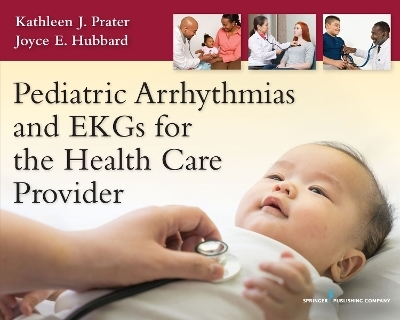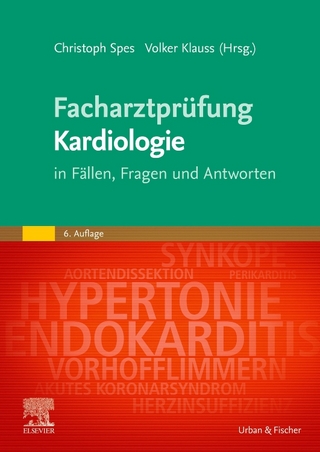
Pediatric Arrhythmias and EKGs for the Health Care Provider
Springer Publishing Co Inc (Verlag)
978-0-8261-9446-6 (ISBN)
- Titel z.Zt. nicht lieferbar
- Versandkostenfrei innerhalb Deutschlands
- Auch auf Rechnung
- Verfügbarkeit in der Filiale vor Ort prüfen
- Artikel merken
This time-tested publication has successfully trained numerous pediatric nurses from a leading children's hospital. Pediatric advanced practice registered nurses and clinical nurse specialists working in acute or critical care settings, as well as physician assistants and medical residents, need to understand the principles of accurate pediatric EKG interpretation and the appropriate follow-up steps necessary for the best patient care. With a total of 100 EKGs, rhythm strips, and interpretations, this comprehensive but concise text analyzes all levels of arrhythmias to allow pediatric health care providers to interpret normal and abnormal pediatric EKGs and rhythm strips with confidence.
This user-friendly, quick reference outlines the basic rules for pediatric arrhythmias and EKG interpretations using a multitude of different EKGs and rhythm strips and basic but critical figures and tables. With the use of a systematic checklist for standard evaluation, the text walks the reader through the essential signs that health care providers must learn to recognize when examining the EKGs and rhythm strips of their pediatric patients. This book culminates in a robust selection of 50 EKGs and additional rhythm strips for practice and a self-test on the material presented in the preceding chapters. The answers can be compared with the cardiologist's interpretations for reinforcement of understanding and application.
Pediatric Arrhythmias and EKGs for the Health Care Provider teaches readers in a quick, at-a-glance approach:
To obtain an interpretable pediatric tracing
To implement a proper measurement method
To understand both normal and abnormal EKGs
To learn the quickest and most accurate QTc method
To follow an organized format for rhythm analysis
To systematically use tables, diagrams, figures, and graphs for interpretation
To interpret with confidence even very complicated tracings
To know which tracings need a pediatric cardiologist's attention
Kathleen Joan Prater, CCT, became a certified cardiac technician through Cardiovascular Credentialing International in 1993 and had a career in cardiac testing that spanned 35 years.
Contents
In Memory of Joyce Ellis Hubbard, MD
Foreword Margaret C. Slota, DNP, RN, FAAN
Preface
Acknowledgments
Important Aspects of EKG Interpretation
Section I. Mechanics
1. The EKG Machine
Computerized Digital EKG Machine
Key Points When Operating an EKG Machine
EKG Settings
Some Reasons for Ordering an EKG
2. How to Produce Quality Tracings
Distractions
Limitations
Artifacts
Artifact Example
Residue
EKG Machine Representative
Section II. Criteria for Pediatric Rhythms and EKGs
3. Technique
Pediatric EKG Hookup Diagram
Pediatric EKG Hookup Instructions
Standardizations
Correct Labeling of Pediatric EKGs
Systematic Checklist
Rhythm Strip Use and Lengths
Dextrocardia
Dextrocardia Hookup and Explanation
4. Fundamentals
Electrical Pathways
Heartbeat Components and Explanations
Normal Pediatric Heart Rates
Determining Heart Rate
Electrocardiographic Paper Grid Dimensions
Tools for Heartbeat Measurement
Determining the Axis of the Heart
Axis Quadrants
Heart Rates of Some Dysrhythmias
Premature Ventricular Complex/Contraction (PVC) Frequency Events Chart
Section III. Pediatric Rhythm Strips and Interpretations
5. Arrhythmias Associated With Specific Medical Conditions or Drugs
Sinus Bradycardia (SB)
Sinus Tachycardia (ST)
Supraventricular Tachycardia (SVT)
Atrial Flutter (AFL)
Atrial Fibrillation (AF)
Junctional Rhythms (JR)
Long QT Syndrome (LQTS)
Ventricular Tachycardia (VT)
Ventricular Fibrillation (VF)
First-Degree Atrioventricular (AV) Block
Second-Degree AV Block Mobitz I
Second-Degree AV Block Mobitz II
Third-Degree AV Block
Left Ventricular Hypertrophy (LVH)
Right Ventricular Hypertrophy (RVH)
Wolff–Parkinson–White (WPW) Syndrome
6. Normal to Advanced Rhythms
Normal Sinus Rhythm (NSR)
Sinus Arrhythmia (SA)
Sinus Bradycardia (SB)
Sinus Tachycardia (ST)
Wandering Atrial Pacemaker (WAP)
Supraventricular Ectopic (SVE) Beat
Supraventricular Tachycardia (SVT)
SVT Pre-Adenosine
SVT Post-Adenosine
Atrial Flutter (AFL)
Wolff–Parkinson–White (WPW) Syndrome
Junctional Rhythm (JR) Morphologies
Premature Junctional Complexes/Contraction (PJC)
Junctional Rhythm (JR)
Junctional Escape Rhythm (JER)
Accelerated Junctional Rhythm (AJR)
Junctional Tachycardia (JT)
Premature Ventricular Complexes/Contractions (PVC)
Multiform Ventricular Couplet
Ventricular Tachycardia (VT)
Torsades de Pointes (TdP)
Ventricular Flutter and Fibrillation (VFL and VF)
Ventricular Fusion Beat (VFB)
First-Degree Atrioventricular (AVB) Block
Second-Degree Atrioventricular Block (AVB) Wenckebach Mobitz I
Second-Degree Atrioventricular (AVB) Block Mobitz II
Third-Degree Atrioventricular (AV) Heart Block (Complete Heart Block)
Long QT Syndrome (LQTS)
Three Interesting Rhythm Strips
Answers to the Three Interesting Rhythm Strips
Section IV. EKGs and Interpretations
7. Pediatric Standards
Tables of Normal Values
Measurement of QT and Calculation for QTc
Sudden Death From Inherited Long QT Syndrome (LQTS)
8. Normal to Advanced EKGs and Interpretations
Normal Sinus Rhythm
Normal Sinus Rhythm Interpretation
Sinus Arrhythmia (SA)
SA Interpretation
Sinus Bradycardia (SB)
SB Interpretation
Sinus Tachycardia (ST)
ST Interpretation
Wandering Atrial Pacemaker (WAP)
WAP Interpretation
Premature Atrial Complexes (PACs)
PACs Interpretation
Supraventricular Tachycardia (SVT)
SVT Interpretation
SVT Pre-Adenosine
SVT Pre-Adenosine Interpretation
Post-Adenosine
Post-Adenosine Interpretation
Junctional Escape Rhythm (JER)
JER Interpretation
Accelerated Junctional Rhythm (AJR) Preceding SB
AJR Preceding SB Interpretation
Junctional Tachycardia (JT)
JT Interpretation
Junctional Ectopic Tachycardia (JET)
JET Interpretation
Permanent Form of Junctional Reciprocating Tachycardia (PJRT)
PJRT Interpretation
Atrial Flutter (AFL) With 2:1 Atrioventricular (AV) Conduction
AFL With 2:1 AV Conduction Interpretation
AFL With 4:1 and 6:1 AV Conduction
AFL With 4:1 and 6:1 AV Conduction Interpretation
Atrial Flutter/Fibrillation (AFL/AF)
AFL/AF Interpretation
Atrial Tachycardia With 2:1 AV Conduction
Atrial Tachycardia With 2:1 AV Conduction Interpretation
First-Degree AV Block
First-Degree AV Block Interpretation
Second-Degree AV Block Mobitz I
Second-Degree AV Block Mobitz I Interpretation
Second-Degree AV Block Mobitz II
Second-Degree AV Block Mobitz II Interpretation
Third-Degree AV Block
Third-Degree AV Block Interpretation
Premature Ventricular Complexes/Contractions (PVCs)
PVCs Interpretation
PVCs as Ventricular Couplets
PVCs as Ventricular Couplets Interpretation
Ventricular Tachycardia (VT)
VT Interpretation
Wide QRS Tachycardia
Wide QRS Tachycardia Interpretation
Possible Ventricular Fibrillation (VF)
Possible VF Interpretation
Ventricular Fusion Beat (VFB)
VFB Interpretation
Hyperkalemia
Hyperkalemia Interpretation
Hypokalemia
Hypokalemia Interpretation
Long QT Syndrome (LQTS)
LQTS Interpretation
T Wave Inversion
T Wave Inversion Interpretation
Left Axis Deviation (LAD)
LAD Interpretation
Right Axis Deviation (RAD)
RAD Interpretation
Left Ventricular Hypertrophy (LVH)
LVH Interpretation
Right Ventricular Hypertrophy (RVH)
RVH Interpretation
RVH and Intraventricular Conduction Delay (IVCD)
RVH and IVCD Interpretation
Biventricular Hypertrophy (BVH)
BVH Interpretation
Left Atrial Enlargement (LAE)
LAE Interpretation
Right Atrial Enlargement (RAE)
RAE Interpretation
Biatrial Enlargement (BAE)
BAE Interpretation
Wolff–Parkinson–White (WPW) Syndrome
WPW Syndrome Interpretation
Lown–Ganong–Levine (LGL) Syndrome
LGL Syndrome Interpretation
Left Bundle Branch Block (LBBB)
LBBB Interpretation
Right Bundle Branch Block (RBBB)
RBBB Interpretation
Dextrocardia
Dextrocardia Interpretation
Deep Q Waves
Deep Q Waves Interpretation
Heart Transplant
Heart Transplant Interpretation
Junctional Rhythm (JR), LAD, and RBBB
JR, LAD, and RBBB Interpretation
Sinus Tachycardia (ST), LAD, and Possible RBBB
ST, LAD, and Possible RBBB Interpretation
Section V. Self-Assessment Workbook
9. Review Worksheets and Questions
10. Answers
Acronyms
Index
| Erscheinungsdatum | 01.06.2017 |
|---|---|
| Zusatzinfo | 100 Illustrations |
| Verlagsort | New York |
| Sprache | englisch |
| Maße | 254 x 203 mm |
| Themenwelt | Medizinische Fachgebiete ► Innere Medizin ► Kardiologie / Angiologie |
| Medizin / Pharmazie ► Medizinische Fachgebiete ► Pädiatrie | |
| Pflege ► Fachpflege ► Anästhesie / Intensivmedizin | |
| Medizin / Pharmazie ► Pflege ► Kinderkrankenpflege | |
| Studium ► 2. Studienabschnitt (Klinik) ► Anamnese / Körperliche Untersuchung | |
| ISBN-10 | 0-8261-9446-X / 082619446X |
| ISBN-13 | 978-0-8261-9446-6 / 9780826194466 |
| Zustand | Neuware |
| Haben Sie eine Frage zum Produkt? |
aus dem Bereich


